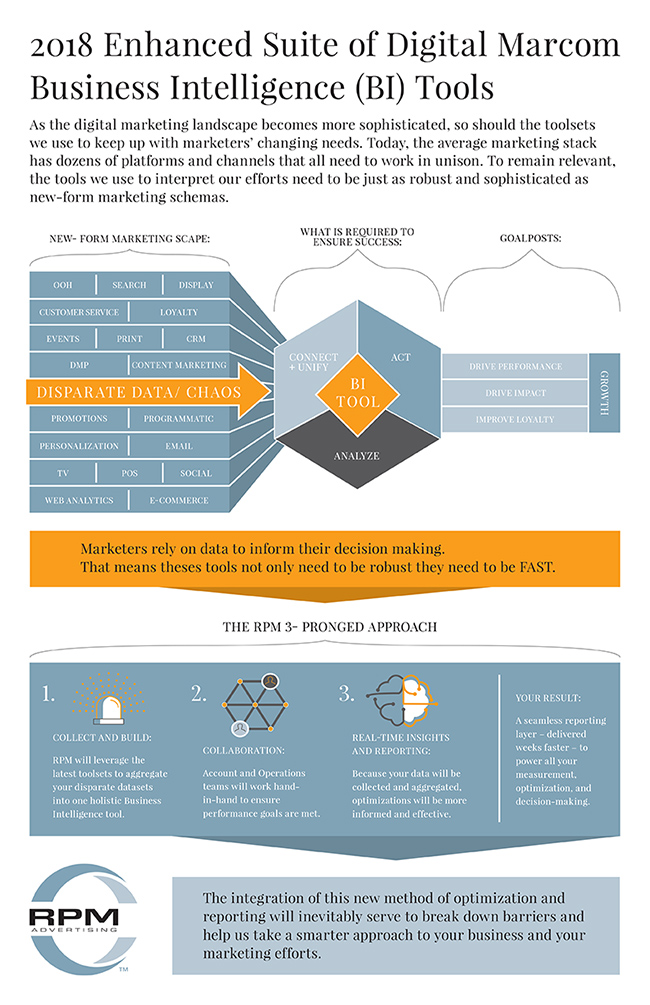Orange Juice
Your
quarterly
vitamin.
Written on 06/12/18 6:06 PM
 Buffering has become many digital marketers’ worst nightmares. When digital ads are served alongside video, buffering can dramatically impact the success – or failure – of digital ads. Unlike display ads, which occur as a webpage loads, video ad calls often don’t take place until the user clicks the play button, and this prompts the buffering cycle – a vicious one that can lose viewers and heighten user frustration.
Buffering has become many digital marketers’ worst nightmares. When digital ads are served alongside video, buffering can dramatically impact the success – or failure – of digital ads. Unlike display ads, which occur as a webpage loads, video ad calls often don’t take place until the user clicks the play button, and this prompts the buffering cycle – a vicious one that can lose viewers and heighten user frustration.
With digital video ad spending in the US estimated to top $17 billion this year, and growth expected to reach $24 billion by 2020, marketers are betting big on video, according to eMarketer. But what if half your audience is giving up on your video ad before they even get to view it? That’s what’s happening, according to a survey of US mobile video viewers. In fact, nearly 60% of respondents reported that they are frustrated with their mobile video viewing experience at least half the time. And while half of these viewers are giving up, nearly one quarter stop using a particular service completely.
Similarly, about 80% of US adults surveyed by Adobe last December said that if a piece of content takes too long to load, they’ll either stop viewing it or switch to a different device.
Frustration is running high, and publishers are making efforts to reduce buffering to keep users on sites longer. With more than 75% of worldwide video viewing on mobile devices, this is a problem publishers need to solve and agencies need to work with clients to address when developing digital video ad campaigns.
by Jennifer Wiza
With only 23% of marketers confident in their ability to use data to optimize customer experience, and an overwhelming volume of data at their disposal, how can you develop a successful strategy? According to Altimeter’s customer research, there are four key steps to leveraging data for an optimal customer experience:

-
Focus on one customer experience category for your objective.
-
Prioritize only the data points you need for customer success.
-
Use a data management platform to view data holistically.
-
Create centralized data insights and experience delivery teams.
Want to learn more? Download the complete report, Creating a Data-Driven Strategy for Customer Experience, here.
by Jennifer Wiza
 Ad-buying and verification can be a very murky process. How can agencies enable greater transparency and clarity for programmatic advertising? At RPM, it starts with providing inventory verification and transparency for digital advertising, which is why we recently moved forward with a trial of Ternio’s blockchain solution for two clients—Terlato Wines and Majestic Star Casino & Hotel.
Ad-buying and verification can be a very murky process. How can agencies enable greater transparency and clarity for programmatic advertising? At RPM, it starts with providing inventory verification and transparency for digital advertising, which is why we recently moved forward with a trial of Ternio’s blockchain solution for two clients—Terlato Wines and Majestic Star Casino & Hotel.
Transparency of the ad supply chain is a focus for many brands and agencies, so the ability to garner this insight in a programmatic environment is key. Both Majestic Star and Terlato will be applying 100% of their online display budget to piloting Ternio’s platform.
Pioneering a highly scalable and fully decentralized blockchain framework, Ternio aims to solve the problems that continually plague digital advertising—lack of transparency, lengthy payment models, and advertising fraud.
The Lexicon framework underlying the operation uses highly modified versions of Hyperledger Fabric and Stellar. As a fully decentralized solution, the smart contracts ensure terms are met, while providing visibility into the transactions in the supply chain. Ternio’s technology provides a communication layer for ultra-fast data transfer and can support the high queries per second (QPS) required for programmatic buying and selling.
Majestic Star will begin piloting a blockchain programmatic advertising campaign in July. In the past, it has been difficult to determine why some campaigns do better than others. The transparency gained though blockchain will change that.
“The goal is to gain real clicks and conversions, says Alex Salinas, advertising manager at Majestic Star Casino & Hotel, located in Gary, Indiana. “In the past we’ve had some strange activity due to bots, which grip onto keywords. Casinos tend to grip onto that traffic.”
Blockchain can eliminate bots, verify users, and reduce fraud. At RPM, we believe that blockchain long-term can reduce costs for RPM and clients, and reach higher quality consumers while giving our team the ability to track and measure metrics as the campaign happens—if changes are needed they can be initiated in the middle of the process.
The integration of this new method of optimization and reporting will inevitably serve to break down barriers and help us take a smarter approach to our clients’ business and marketing efforts.
by Jennifer Wiza
All over the America people are discovering a uniquely Italian bubbly beverage. Indeed, prosecco is most definitely having a moment. And RPM’s continuing campaign for Riondo Prosecco from Terlato Wines plans to make the most of it.
Beginning this spring, Riondo’s signature stripes and colors, as well as the bold look and language, will be splashed across an array of print publications, social media, banners and streaming audio coast to coast. It’s multi-channel national advertising with push-and-pull messaging that’s sure to build big on last year’s incredible success.
The Italian-inspired campaign will take wine drinkers on a playful journey complete with sun and fun and everything summer. With even more influencer marketing and digital initiatives this year, the Riondo brand is sure to be the go-to prosecco in 2018.
Over the coming months, Riondo will also take over the shelves with catchy and colorful display enhancers, stylish racks and big, bold club store tray packs. Branded point-of-sale clings, exciting in-store giveaways and coveted placements will definitely have customers asking for it by name.
Throughout the marketing effort, RPM has wisely positioned Riondo as something more approachable, more inclusive and genuine. Unlike prosecco brands that aspire to be special occasion, champagne-like brands, Riondo is the authentic Italian way to make every day more bubbly. For consumers, it’s the easy prosecco choice – the essence of laid-back, enjoyable Italian living.
2018 promises to be an exciting year for Riondo with greater distribution, including the addition of Walmart stores. And with the RPM campaign in full swing, there’s sure to be more excitement, more internet buzz and more sales this year than ever before. So get ready for Riondo Season. And let’s toast the good life, Italian-style. “Salute!”



What if a teacher could design a lesson that he knew his students would remember 20 years later? What if a manager knew how to create an experience that would delight customers?
As marketers, our days are spent trying to figure out how to make our brand experience memorable. But what’s a memorable moment? In his book, The Power of Moments: Why Certain Experiences Have Extraordinary Impact, author Chip Heath looks at the mysteries of “experience.”
In an age where marketing has become as much science as art, Heath’s book offers fascinating insight into how experiences can stick with us long after the moment, and impact how we think and act years later.
View the video below to see Heath explain the puzzle of our memories of experiences.
RPM recently introduced a new, more effective digital optimization, reporting and cloud data storage solution for Client-Partners. The new tools provide each client with customized dashboards and reporting tools for real-time data about consumer and campaign performance. This data will be used to inform real-time optimization decision-making – from the initiation of a holistic digital campaign all the way through optimization.
RPM’s brand new suite of business intelligence tools are intuitive, agile, real-time, and come complete with a cloud data storage solution that provides the most granular view of a client’s digital campaign’s program performance.
The new tool means that clients can take advantage of the benefits that come with:
- Always-on performance, near real-time, 12-hour snapshots and trend analysis
- A deep granular understanding of channel and campaign performance
- Faster optimizations and reporting
- Intuitive, user-centric web-based dashboards
In addition to the tool, clients receive monthly communications containing a link to the custom as well as additional reporting (such as executive-level briefs) that may be helpful to marketing teams.
To learn more about this enhanced suite of digital marcom business intelligence (BI) tools, see the infographic below.

Attribution Modeling – Holy Grail or …
 Attribution. It’s the word on every marketer’s lips, and it’s impacting how media budgets are developed and optimized. But in today’s multi-channel environment, attribution “science” may not be telling the whole story. While attribution modeling provides increased visibility into a customer’s journey, models often tell only part of the story – on-line conversions and channels. If your data shows that a significant portion of conversions have long, multi-step paths – meaning customers are engaging across multiple channels – you may have an attribution gap.
Attribution. It’s the word on every marketer’s lips, and it’s impacting how media budgets are developed and optimized. But in today’s multi-channel environment, attribution “science” may not be telling the whole story. While attribution modeling provides increased visibility into a customer’s journey, models often tell only part of the story – on-line conversions and channels. If your data shows that a significant portion of conversions have long, multi-step paths – meaning customers are engaging across multiple channels – you may have an attribution gap.
Attribution – On-line-to-off-line
If you don’t understand how online channels impact on offline revenue, you’re only seeing part of the story. Only looking at digital conversions and revenue fails to take into account the effect on offline sales and in-store visits. Of course, one way to address this is with unique promotion codes by channel to fill the gaps in the story, which allows you to track conversion. Google’s “In-Store Visits” metric uses multiple signals to determine online/offline impact, including Google Maps data, WiFi, GPS and more to create in-store visit estimates, but this only applies to the million opted-in users.
Platforms that leverage mobile device data are also a step in the right direction, although they don’t track a specific user’s activity.
Attribution – Cross-device
The proliferation of devices has created another attribution challenge – measuring consumer behavior and engagement across devices and screens. The migration of search away from taps on the screen and toward voice-recognition tools will only make this more difficult. Although some companies can begin to make headway through multiple screen and device logins, it remains an area of opportunity.
Attribution modeling will only continue to improve as tools emerge to support a holistic approach to campaigns – across channels and across devices. Working with an attribution model that supports holistic marketing campaigns and efforts while avoiding simplistic “first- or last-click” approaches will help ensure multi-channel campaign optimization. Tracking the interplay of on- and off-line behavior and activity isn’t easy, but it can be addressed with unique promotional codes tying back to the individual channel. Regardless of attribution model, challenges and opportunities remain for improvement as we seek to understand consumer behavior and invest in the areas of greatest value.
 Bigger isn’t always better, at least not when it comes to social media influencers. Recent research shows that Instagram micro-influencers and macro-influencers garner similar average engagement rates on sponsored posts. Macro-influencers have greater reach than micro-influencers, so it’s no surprise that macro-influencer engagement levels are high in absolute terms, such as likes and comments. But when it comes to average engagement rate, size does matter. In fact, according to another study, engagement declines as followers increase.
Bigger isn’t always better, at least not when it comes to social media influencers. Recent research shows that Instagram micro-influencers and macro-influencers garner similar average engagement rates on sponsored posts. Macro-influencers have greater reach than micro-influencers, so it’s no surprise that macro-influencer engagement levels are high in absolute terms, such as likes and comments. But when it comes to average engagement rate, size does matter. In fact, according to another study, engagement declines as followers increase.
- Instagram users with fewer than 1,000 followers generated likes 8% of the time
- Users with 1,000-10,000 followers earned likes at a 4% rate
- Users with 10,000-100,000 followers achieved a 2.4% like rate
- Users with 100,000-10 million followers earned likes only 1.7% of the time
- So how do you choose the right influencer strategy for your brand? First, let’s look at the differences.
Micro-influencers typically have around 500-10,000 followers and, while they don’t have the large reach of macro-influencers, they do hold significant sway with their audience. Followers value the influencer’s personal opinions, making micro-influencers great for higher brand engagement opportunities because of the perceived one-on-one nature of the relationship with followers. Micro-influencers are able to have high-value dialog with followers due to the intimate nature of the influencer/follower relationship, and this can greatly benefit a brand seeking to connect with the influencer’s audience.
With 10,000-1 million followers, macro-influencers tend to focus on a specific area or topic. This attracts followers looking to engage with content specific to one area of interest, for example food or cars. Macro-influencers can become “famous” to a distinct set of people, which benefits brands looking to go deep rather than wide.
Then there are the mega-influencers, who tend to be social media celebrities with over 1 million followers. Due to the scale of their following, mega-influencers don’t receive the engagement of micro- or macro-influencers, but they do have big reach. And big reach means bigger investment.
So which influencer is right for your brand? Each has its benefits, depending on your goal. Do you want a highly engaged niche audience, and are willing to sacrifice experience with sponsored content (and perhaps the “professionalism”) of macro-influencers? A micro-influencer might be right for your brand. Looking for larger reach but willing to forego high engagement? A macro-influencer may be the way to go. Of course, choosing the right influencer is key to ensuring that your strategy – regardless of size – delivers the result you’re after.
 When our Client-Partner, Thunder Valley Casino Resort, made an adjustment to their customer relationship marketing program, specifically the redemption policies for its buffet, it had a negative impact on covers in the restaurant for 2017. In response, RPM was charged with developing a marketing program to drive business back to the buffet. The result was a TV spot within the “Live Out Loud” campaign that positioned the restaurant as a fantasy dining experience, a feast for the senses at each and every station in the buffet. The campaign launched in mid-September and by the end of the first month, revenue had increased significantly over the same period a year earlier. On YouTube, “Chef Spectacular” has already exceeded 35k views. On track to outpace revenue projections for the year, the increased buffet traffic adds incremental revenue to Thunder Valley’s casino floor. As we like to say, game on!
When our Client-Partner, Thunder Valley Casino Resort, made an adjustment to their customer relationship marketing program, specifically the redemption policies for its buffet, it had a negative impact on covers in the restaurant for 2017. In response, RPM was charged with developing a marketing program to drive business back to the buffet. The result was a TV spot within the “Live Out Loud” campaign that positioned the restaurant as a fantasy dining experience, a feast for the senses at each and every station in the buffet. The campaign launched in mid-September and by the end of the first month, revenue had increased significantly over the same period a year earlier. On YouTube, “Chef Spectacular” has already exceeded 35k views. On track to outpace revenue projections for the year, the increased buffet traffic adds incremental revenue to Thunder Valley’s casino floor. As we like to say, game on!
 Analytics is embedded in everything today’s marketers do. This not only requires a cultural shift that impacts how marketing teams work together as much as it impacts what they do. An analytical marketing approach requires that teams act differently, as much as it demands that they think differently based upon what data is telling them.
Analytics is embedded in everything today’s marketers do. This not only requires a cultural shift that impacts how marketing teams work together as much as it impacts what they do. An analytical marketing approach requires that teams act differently, as much as it demands that they think differently based upon what data is telling them.
In this Harvard Business Review article, Adele Sweetwood, the Senior Vice President of Global Marketing and Shared Services at SAS, looks at three approaches to build an analytical culture. The idea of a “common analytical culture” helps organizations develop the ability to make adjustments on the fly, creating the opportunity to implement real-time changes and empowering the marketing [are we missing a word here? Team? Group?] to respond more quickly. She looks at three ways that teams in an analytical culture must think differently.
- Use data to change the status quo – Teams need to think differently about marketing because the availability of new data and metrics allow them to be more effective and enable them to identify new approaches
- Use stories to convey data insights – Teams can ask what-if questions to uncover other stories it can begin to tell, enabling teams to shift from being reactive to proactive, creating a culture focused on the future, rather than having one weighed down by the past.
- Use different metrics – In the past, metrics provided something to react to, but today reacting to metrics isn’t enough. Customers now have greater expectations about what they expect us to know as marketers and how we interact with them.
Learn more about how an analytics mindset changes marketing culture, read the full article here.